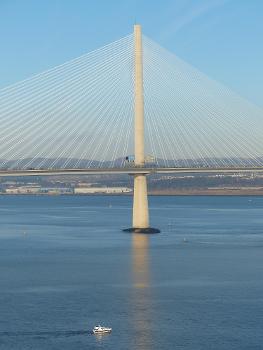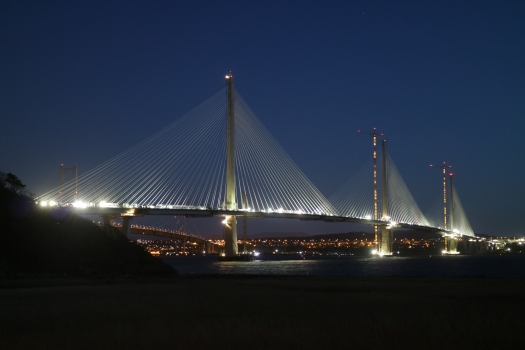General Information
| Other name(s): | Forth Replacement Crossing; New Forth Bridge |
|---|---|
| Beginning of works: | September 2011 |
| Completion: | 30 August 2017 |
| Duration of works: | 5.5 years |
| Status: | in use |
Project Type
| Structure: |
Cable-stayed bridge with semi-fan system |
|---|---|
| Function / usage: |
Tramway, light or metro rail bridge |
| Structure: |
Multiple-span cable-stayed bridge |
| Material: |
Steel-reinforced concrete composite bridge |
| Function / usage: |
Road bridge |
| Support conditions: |
for registered users |
| Plan view: |
Structurae Plus/Pro - Subscribe Now! |
| Material: |
Structurae Plus/Pro - Subscribe Now! |
| Secondary structure(s): |
Structurae Plus/Pro - Subscribe Now! |
| Material: |
Structurae Plus/Pro - Subscribe Now! |
| Secondary structure(s): |
Structurae Plus/Pro - Subscribe Now! |
Awards and Distinctions
| 2020 |
Bronze Award
for registered users |
|---|---|
| 2018 |
finalist
for registered users |
Location
| Location: |
Queensferry, Edinburgh, Scotland, United Kingdom North Queensferry, Fife, Scotland, United Kingdom |
|---|---|
| Crosses: |
|
| Next to: |
Forth Road Bridge (1964)
|
| Coordinates: | 56° 0' 10.41" N 3° 24' 45.15" W |
Technical Information
Dimensions
| total length | 2 638 m | |
| main spans | 2 x 650 m | |
| span lengths | 64 m - 80 m - 90 m - 3 x 87 m - 89 m - 104 m - 221 m - 2 x 650 m - 221 m - 104 m - 99 m | |
| number of spans | 14 | |
| deck | deck width | 39.80 m |
| pylons | height | 207 m |
| dimensions of pylon foot | 14.00 m x 16.00 m | |
| stay cables | number of cables | 288 |
Materials
| piers |
reinforced concrete
|
|---|---|
| girder |
steel
|
| pylons |
reinforced concrete
|
| deck slab |
reinforced concrete
|
| abutments |
reinforced concrete
|
Case Studies and Applied Products
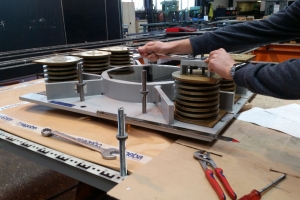
Design of bearings for the Queensferry Crossing, Scotland
A special design has been developed for the vertically-oriented bearings between the towers and the deck of the Queensferry Crossing across the Firth of Forth.
[more]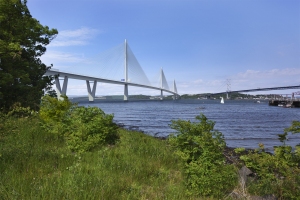
First for Forth – the Queensferry Crossing in Scotland
The Queensferry Crossing, currently under construction across the Firth of Forth near Edinburgh, Scotland, is being built to carry most of the traffic that is currently carried by the magnificent Forth Road Bridge, which has been in serv ... [more]
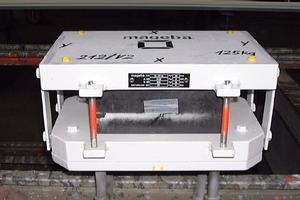
LASTO®BLOCK – Elastomeric Bearings
mageba elastomeric bearings, which conform to various international standards, such as the EN1337, DIN4141, BS5400 and AASHTO, are used globally for bridges and other engineering constructions.
[more]
Queensferry Crossing Bridge is due to open
The Queensferry Crossing Bridge in Scotland is due to open by the end of August 2017. The 2.7 km long bridge will accommodate the M 90 Motorway on four lanes and will be the world's longest stay cable bridge with three pylons. Queensferr ... [more]
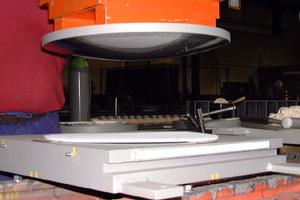
RESTON®SPHERICAL – Spherical bearings
mageba spherical Bearings are especially suited for bridges with big torsions and bridges located in very cold areas (temperatures lower than -30°C).
[more]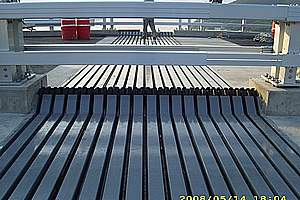
TENSA®MODULAR LR & LR-LS – Modular expansion joints
Modular Expansion Joints can be constructed for any movements, from about 100 mm up to 2,000 mm and more. They allow movements in all 3 directions and rotations around all 3 axes.
[more]Chronology
| 3 February 2017 | Lifting of the last deck element. |
|---|
Excerpt from Wikipedia
The Queensferry Crossing (formerly the Forth Replacement Crossing) is a road bridge in Scotland. It was built alongside the existing Forth Road Bridge and carries the M90 motorway across the Firth of Forth between Edinburgh, at South Queensferry, and Fife, at North Queensferry.
Proposals for a second Forth Road crossing were first put forward in the 1990s, but no action was taken until structural issues were discovered in 2004. In 2006-2007 Transport Scotland carried out a study to examine the options and in December 2007, the decision was made to proceed with a replacement bridge. The following year it was announced that the existing bridge would be retained as a public transport link. The Forth Crossing Act received Royal Assent in January 2011. In April 2011, the Forth Crossing Bridge Constructors Consortium were awarded the contract and construction began in late Summer/Autumn of 2011.
The Queensferry Crossing is a three-tower cable-stayed bridge, with an overall length of 2.7 kilometres (1.7 miles). Around 4 kilometres (2.5 miles) of new connecting roads were built, including new and upgraded junctions at Ferrytoll in Fife, South Queensferry and Junction 1A on the M9.
The bridge was first due to be completed by December 2016, but this deadline was extended to August 2017 after several delays. It is the third bridge across the Forth at Queensferry, alongside the Forth Road Bridge completed in 1964, and the Forth Bridge completed in 1890. Following a public vote, it was formally named on 26 June 2013 and opened to traffic on 30 August 2017. The official opening was carried out on 4 September 2017 by Queen Elizabeth II, fifty-three years to the day after she opened the adjacent Forth Road Bridge.
Background
A crossing route over the Forth had existed at the site since the eleventh century, when the queen of Scotland, Margaret, founded a free ferry to take pilgrims north to St Andrews. The site of the ferry crossing became the location of the Forth Road Bridge, which opened in 1964. Proposals for an additional road crossing at Queensferry were drawn up in the early 1990s, as part of the "Setting Forth" consultation document prepared by the Scottish Office. The plans met stiff opposition from environmentalists and from the City of Edinburgh Council on the grounds of the increased traffic. Following the Labour victory in the 1997 general election, the proposals were shelved.
The existing bridge had a planned design life of 120 years, but by the early years of the 21st century the planned theoretical capacity for the bridge was being routinely exceeded. It was designed for up to 11 million vehicles per year, but this had risen steadily to 23 million vehicles in 2006. Between 2003 and 2005, an inspection programme found that the main suspension cables had suffered an estimated 8–10% loss of strength as a result of corrosion. Projections highlighted the likelihood of an accelerating loss of strength, with traffic restrictions to limit loading required in 2014 in the worst-case scenario.
The strategic transport importance of the road bridge – and the threat of closure by 2019 if major structural work was not successful – led to fears of serious economic consequences, especially as work on a new crossing was estimated to take up to 11 years. Scottish Transport Minister Nicol Stephen commissioned a new study, which priced a second Forth Road Bridge at £300 million, in 2003. The Forth Estuary Transport Authority voiced support for a new bridge in 2005, and in 2006 the UK Transport Secretary, Alistair Darling, spoke in favour of the idea.
Planning
In 2007, the Forth Replacement Crossing Study was commissioned by Transport Scotland to examine various options for new bridges or tunnels across the Forth. The report recommended adoption of a cable-stayed bridge, located to the west of the Forth Road Bridge, as the preferred solution. The study concluded that this option was significantly cheaper than a tunnel, would take less time to construct, and would represent better value for money, though it was noted that a tunnel would have fewer environmental impacts. In December 2007 finance secretary John Swinney announced that a new cable-stayed bridge would be constructed, with an estimated cost of between £3.25 billion and £4.22 billion. He claimed it would be "the largest construction project in a generation in Scotland".
There was opposition to the project on environmental, traffic and cost grounds. The ForthRight Alliance, an umbrella group including Friends of the Earth, the Scottish Green Party, the RSPB, sustainable transport groups and other local organisations, opposed the scheme as being "both unwelcome and unnecessary". Another group, Forth Tunnel Action Group, campaigned for a tunnel as the solution with lowest costs and fewest long-term environmental impacts.
It was initially suggested that the new bridge would be funded via the Scottish Futures Trust, an alternative to public-private partnership funding for major public-sector schemes. However, the Scottish Government announced in December 2008 that public funding would be used. As part of the Scottish Government's Strategic Transport Projects Review, the new Forth crossing was priced at between £1.72 billion and £2.34 billion. Under the revised scheme, the existing bridge will be retained for public transport, cyclists and pedestrians, and the new bridge was to be operational by 2016.
A joint venture between consultancies Arup and Jacobs was appointed as project manager, and in February 2008 environmental and technical studies were begun, continuing through 2009. Public consultations were held, and some changes to the scheme were made in response to the comments received. An environmental statement was published in November 2009, coinciding with the introduction of the Forth Crossing Bill into the Scottish Parliament by John Swinney. A majority of MSPs voted in favour of the new legislation on 16 December 2010, and the Forth Crossing Act received Royal Assent in January 2011.
Bidding process
In 2009, Transport Scotland solicited for tenders to construct the proposed bridge. Although Transport Scotland received 39 expressions of interest, concerns over the risks associated with the fixed-price contract resulted in only two consortia of large construction companies bidding. Due to the bidders' concerns that the bidding process itself would prove to be an expensive proposition, the Scottish Government allocated £10 million to defray the bidders' costs during the full bidding process, should the project be abandoned.
The two consortia were Forthspan, which included Morgan Sindall, BAM Nuttall and Balfour Beatty; and Forth Crossing Bridge Constructors (FCBC), which consists of Dragados, Hochtief, American Bridge, and Morrison Construction. Bids for the main contract, priced at between £900m and £1.2bn, and including design and construction of the bridge and approach roads, were submitted in January 2011. In March 2011 the Scottish Government announced FCBC as preferred bidder, with a bid of £790 million. Ramboll is leading the Design Joint Venture which includes Sweco and Leonhardt Andra and Partners.
In addition to the main contract, two smaller contracts form part of the scheme. The contract to implement the Intelligent Transport System (ITS) traffic management system in Fife was awarded to John Graham (Dromore) Ltd, with a tender of £12.9 million, while the upgrade of M9 Junction 1a was awarded to a joint venture between John Sisk and Roadbridge, with a tender of £25.6 million. As with the main contract, the tenders received were below the original estimated budgets. Naeem Hussain, Global Bridge Design Practice Leader at Arup, was the lead design engineer for the project.
Construction
Preparatory works for the new bridge began in September 2011 with works beginning at the southern end of the M90 to build the northern approach roads. 149 segments of bridge deck, each of which is 12 metres (39 ft) long and 40 metres (130 ft) wide, were constructed in China and Spain, then delivered by sea in October 2013. The approach steel bridge sections were manufactured by Cleveland Bridge UK in Darlington.
The towers reached 160 metres (525 ft) in height in August 2015, making it the UK's tallest bridge. The completed towers stand at 207 metres (679 ft).
On 28 April 2016, one construction worker was killed and another injured in an accident involving a crane. Work on the bridge was halted to allow an investigation to take place.
The bridge was due to be completed by December 2016, but that date was put back to May 2017 due to weather delays slowing construction, with 25 days lost due to high winds during April and May 2016. An additional delay was announced in March 2017 again due to weather (more specifically, high winds) and an estimation period of six weeks in July / August 2017 was proposed.
The bridge opened on 30 August 2017 and formally opened by the Queen on 4 September 2017.
The bridge
The Queensferry Crossing (left) in relation to the Forth Road Bridge (centre) and the Forth Bridge (right) The Beamer Rock, prior to removal of the lighthouse to make way for the bridge
The bridge is a cable-stayed structure, with three towers each 207 metres (679 ft) high. Including approaches, the overall length of the bridge is 2.7 kilometres (1.7 miles); at opening, it is the longest triple tower cable-stayed bridge in the world. The bridge carries motor-cycles, cars and heavy goods vehicles, while public transport, cyclists and pedestrians use the existing bridge. Wind shielding has been built into the design, to enable use of the bridge in high winds, which regularly led to restrictions on the existing bridge.
The bridge is the third crossing of the Forth at Queensferry, alongside the Forth Road Bridge, completed in 1964, and the Forth Bridge, a railway bridge completed in 1890. It is sited west of the road bridge, with the northern landfall at St Margaret's Hope, between Rosyth Dockyard and North Queensferry and the southern landfall just west of Port Edgar in South Queensferry. The central tower was constructed on the Beamer Rock, a small islet in the Forth. The project was known as the Forth Replacement Crossing, and a name for the new bridge was selected in a public vote in 2013 after a panel of independent advisers provided a shortlist of possible names. A short-list of five names were selected, these were Caledonia Bridge, Firth of Forth Crossing, Queensferry Crossing, Saltire Crossing and St Margaret's Crossing. A public vote was held up until 7 June 2013 and the Queensferry Crossing name received the most votes, with 12,039 (of 37,000) votes (32%) in a public poll.
Connecting roads
This section needs to be updated. In particular: since the bridge has been opened, the connecting roads presumably have been rearranged. Please update this article to reflect recent events or newly available information. (September 2017)
Several new and upgraded roads connect the bridge into the existing road network with around 4 kilometres (2.5 miles) of new roads to be constructed. These new roads will join the M9 and M90 motorways together for the first time, with the Queensferry Crossing being built to motorway standard in order to carry the M90 across the Forth. The M90 motorway terminates at Admiralty Junction, around 3 kilometres (1.9 miles) north of the current Forth Road Bridge, with the road continuing as all-purpose dual carriageway across the existing bridge and joining the M9 via the M9 Spur.
Admiralty Junction
Admiralty Junction, the present Junction 1 of the M90 motorway will be unaltered, with the exception of a bus lane to be added on the southbound carriageway. The junction will be renumbered to Junction 1C of the M90 when the Queensferry Crossing opens.
Ferrytoll Junction
Ferrytoll Junction will be redesigned to give access to the new crossing and to maintain public transport access to the Forth Road Bridge. The design of the new junction requires the realignment of the B981 road to North Queensferry. Ferrytoll Junction will be numbered Junction 1B of the M90 following completion of the Queensferry Crossing.
South Queensferry Junction
The M90 will be extended west from the current bridge access at Ferry Muir, wrapping around South Queensferry to the southern landfall of the new crossing. A grade-separated junction will be built on the A904 just west of Echline, at the south-west edge. The existing access from the Forth Road Bridge to the A90 will remain open to public transport. South Queensferry Junction will become Junction 1A of the M90 when the Queensferry Crossing opens.
M9 Junction 1a
Junction 1a provides access from the M9 to the Forth Road Bridge via the M9 Spur. Originally, only east-facing connections were provided to the M9, forcing traffic heading west from the bridge onto the A904 through the village of Newton in West Lothian. The upgrade of the junction included new west-facing slip roads, enabling direct access onto the M9 from the Forth Road Bridge and the new crossing, as well as widening of the existing connections to assist the flow of traffic at peak times. The improvements were completed in February 2013 at a cost of £25.6m. The M9 Spur will become the M90 upon completion of the Queensferry Crossing, the junction connecting the A90 coming from the Forth Road Bridge with the A90 towards Edinburgh city centre and the M9 Spur will be named the Scotstoun Junction and will be numbered as Junction 1 of the M90.
Intelligent Transport System
An "Intelligent transportation system" (ITS) will be installed between Halbeath on the M90, and the M9, covering the whole scheme. The ITS is a Active traffic management, enabling variable speed restrictions and lane closures to be displayed on overhead gantries.
Archaeological finds
During routine archaeological excavations by Headland Archaeology in advance of work on the new bridge archaeological deposits from the Mesolithic were found on both sides of the Forth.
On the northern side two post built structures and their surrounding pits and were dated to the mid to late Mesolithic period.
On the south bank in a field at Echline the remnants of a sunken floor structure with in situ floor deposits was found. The structure, based around an oval pit approximately 7 metres (23 ft) in length, contained the remains of a hearth, stone tools, and bone from a variety of animals. Radio-carbon analysis returned a date of c.8300, approximately 1000 years older than the northern site, making it the earliest known dwelling in Scotland. Additionally three isolated Neolithic pits and a Bronze Age pit group and pit alignment were identified.
Text imported from Wikipedia article "Queensferry Crossing" and modified on July 23, 2019 according to the CC-BY-SA 4.0 International license.
Participants
Relevant Web Sites
Relevant Publications
- (2017): 16.13: Queensferry crossing cable-stayed composite bridge. In: ce/papers, v. 1, n. 2-3 (September 2017), pp. 4143-4152.
- Bridge leads Forth field. In: Bridge Update, n. 70 (September 2007), pp. 2.
- (2018): Cable Stays – Queensferry Crossing. Presented at: IABSE Symposium: Tomorrow’s Megastructures, Nantes, France, 19-21 September 2018, pp. S19-1.
- (2024): Capability analysis of computational fluid dynamics models in wind shield study on Queensferry Crossing, Scotland. In: Proceedings of the Institution of Civil Engineers - Bridge Engineering, v. 177, n. 1 (March 2024), pp. 1-13.
- (2016): Challenges in the Design and Construction of the Queensferry Crossing. Presented at: IABSE Congress: Challenges in Design and Construction of an Innovative and Sustainable Built Environment, Stockholm, Sweden, 21-23 September 2016, pp. 2685-2692.
- About this
data sheet - Structure-ID
20035508 - Published on:
14/03/2008 - Last updated on:
25/12/2021

.jpg)
